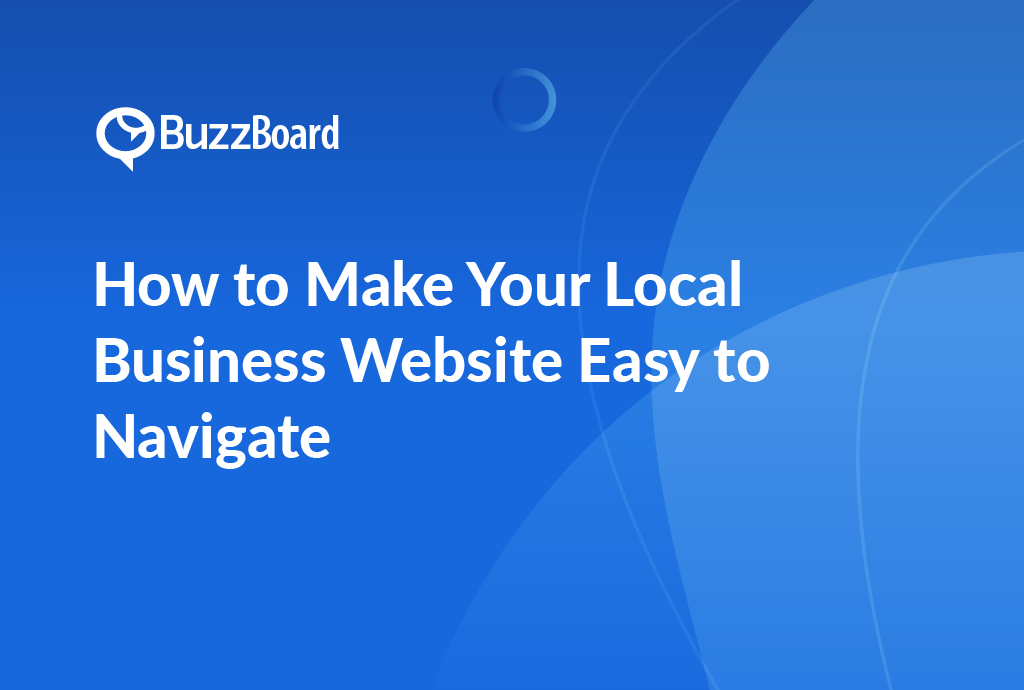Local Business Website Navigation
Make your local business website user-friendly and accessible to customers with these actionable tips. Learn how to simplify your website’s navigation, reduce bounce rates, and increase conversions. Discover the importance of clear categorization, concise content, and intuitive menus. Follow these expert tips to create a seamless user experience and boost your online presence
The importance of having a well-navigated website for local businesses
Navigating a website can feel like traversing a bustling city for the first time. The lack of clear signage, well-marked routes, and accessible directories can quickly turn the journey into an overwhelming and frustrating ordeal. This may push you as a visitor to consider better-prepared alternatives.
In the world of digital marketing, the importance of a well-navigated website for local businesses is pivotal.
Customers typically begin their journey with an online search. A well-structured website navigation improves the visibility of your products or services, enhancing the likelihood of customer conversion. It’s akin to having a well-staffed, sign-posted physical storefront.
A well-designed and navigable website is a crucial component of a local business’s online presence, and it plays a significant role in improving its visibility on search engines like Google. Google’s algorithms favor websites that are well-structured, easy to crawl, and provide a seamless user experience. This, in turn, boosts the website’s SEO ranking, making it more likely to appear at the top of search engine results pages (SERPs) and attract more organic traffic.
So, how can local businesses achieve effective website navigation? The key is to create a website that is intuitive, easy to use, and provides a clear path for visitors to find the information they need. Here are some best practices to follow:
- Organize menu items in a logical and straightforward manner: Make sure that your website’s menu is well-organized and easy to navigate. Group related pages together, and use clear and concise language to describe each menu item.
- Map the user’s journey: Think about how visitors will traverse your website and create a clear path for them to follow. Identify the most important pages and make sure they are easily accessible from the homepage.
- Make essential pages easily accessible: Ensure that your website’s most important pages, such as the contact page, about page, and services page, are easily accessible from the homepage and other key pages.
- Test and monitor website navigation usability: Regularly test your website’s navigation to ensure that it is user-friendly and easy to use. Monitor user behavior and gather feedback to identify areas for improvement.
- Use clear and concise language: Use clear and concise language throughout your website to help visitors quickly find the information they need.
- Use visual hierarchy: Use headings, subheadings, and bullet points to create a visual hierarchy that helps visitors quickly scan and understand the content on your website.
- Use breadcrumbs: Use breadcrumbs to help visitors keep track of their location on your website and provide a clear path to return to previous pages.
- Provide alternative navigation options: Provide alternative navigation options, such as a search bar or a site map, to help visitors find specific pages or content on your website.
By following these best practices, local businesses can create a website that is easy to navigate, provides a seamless user experience, and helps to improve their visibility on search engines like Google.
In addition to improving website navigation, local businesses should also focus on attracting and retaining local customers. In a digital marketplace, attracting and retaining local customers is vital for survival and growth. Investing in your website’s navigation could be the game-changing strategy you need to attract and retain more customers.
For digital marketing agencies, providing local businesses with well-navigated websites should be a high priority. A well-navigated website presents potential benefits, such as improved SEO ranking, increased user engagement, and increased conversions. By providing local businesses with well-navigated websites, digital marketing agencies can position themselves as essential partners in the local businesses’ success.
Understanding the elements of local business website navigation
Understanding the elements of local business website navigation is crucial for improving user experience, increasing website engagement, and ultimately, attracting local customers. A well-designed navigation system can make all the difference in converting visitors into loyal customers. There are five key elements that impact efficient local business website navigation, and by mastering these elements, you can optimize your clients’ website navigation to drive business success.
Simplicity
The first and most essential element of local business website navigation is simplicity. Navigation labels and site structuring should be easy to understand, ensuring a smooth and quick navigational experience for the user. A clutter-free and intuitive navigation menu helps users find what they’re looking for quickly, reducing bounce rates and increasing the chances of conversion. To achieve simplicity, use clear and concise language, avoid using jargon or technical terms, and organize content in a logical and hierarchical manner.
Search Bar Functionality
For websites with a large volume of content, search bar functionality is a game-changer. It enables customers to locate their desired content with ease, saving them time and effort. A robust search bar should be able to filter results by category, keyword, or date, and provide relevant suggestions as the user types. This feature is particularly useful for local businesses with extensive product or service offerings, allowing customers to quickly find what they need.
Breadcrumb Navigation
Breadcrumb navigation is another essential element of local business website navigation. This feature provides customers with a guide on their site journey, illustrating the path leading back to their current location. Breadcrumbs help users keep track of their progress, making it easier to navigate back to previous pages or find related content. This feature is particularly useful for e-commerce websites, allowing customers to easily navigate back to previous product pages or find related products.
Mobile-Friendly Navigation
In today’s mobile-first world, mobile-friendly navigation is no longer a nicety, but a necessity. A significant number of local customers access sites using mobile devices, and prioritizing mobile-friendly navigation meets the needs of this group. A mobile-friendly navigation menu should be easy to use, with clear and concise labels, and a responsive design that adapts to different screen sizes. By prioritizing mobile-friendly navigation, you can increase website traffic, improve user engagement, and drive conversions.
Consistency
Consistency is the final element of local business website navigation. It’s crucial to maintain the same navigation structure on all site pages to avoid confusion and enable intuitive navigation. Consistency ensures that users know what to expect from your website, making it easier for them to find what they’re looking for. To achieve consistency, use a consistent navigation menu across all pages, and ensure that all content is organized in a logical and hierarchical manner.
By refining your clients’ website navigation, you can enhance the visibility of their services, drawing in more local customers. To achieve this, tailor these practices to your clients’ unique needs and their customers’ browsing preferences. For example, if your client has a large product catalog, prioritize search bar functionality to help customers quickly find what they need. By mastering the elements of local business website navigation, you can drive business success, increase website engagement, and attract more local customers.
How to improve your local business customers’ experience via easy website navigation
A successful local business strategy must incorporate digital opportunities to stay competitive and attract a loyal customer base. One often overlooked yet crucial aspect of this strategy is local business website navigation. A well-designed and user-friendly navigational structure can significantly enhance the customer experience, leading to increased conversions, customer retention, and ultimately, business growth.
Website navigation serves as a roadmap for your site’s content, guiding customers through their journey and playing a critical role in customer retention. When customers can easily locate what they seek, they are more likely to make a purchase, return in the future, and recommend your business to others. On the other hand, a complex or confusing navigational structure can deter customers, leading to frustration, abandonment, and ultimately, lost sales.
To optimize your local business website navigation, it is essential to ensure it is simple, intuitive, and easy to use. Avoid using industry jargon or overly technical language that may confuse inexperienced users. Instead, use clear, concise language that is easy to understand. This will help to build trust with your customers and make them feel more comfortable navigating your site.
In addition to simplicity, it is also crucial to ensure that your site is readily accessible on various devices. With the increasing use of smartphones, it is essential to develop a mobile-friendly site that provides a seamless navigation experience across all devices. This means that your site should be optimized for mobile devices, with a responsive design that adapts to different screen sizes and devices.
Applying groups and labels can also enhance website navigation. Organize your services or products into logical categories and label them using standard terms that your customers will recognize. This will help to make your site more user-friendly and easier to navigate. For example, if you are a restaurant, you could have categories such as “Breakfast,” “Lunch,” and “Dinner” to help customers quickly find what they are looking for.
Another important aspect of website navigation is the inclusion of an internally linked site map. A site map presents visitors with an overview of your site’s content and offers a quick means to locate specific sections. This can be especially helpful for customers who are new to your site or are looking for specific information. You can also incorporate external links to relevant, trustworthy content to further enhance the user experience. This can include links to industry associations, government websites, or other reputable sources.
Incorporating a search function can also improve website navigation. A search function allows customers to quickly find what they are looking for, even if they are not sure where to look. This can be especially helpful for customers who are looking for specific products or services.
Finally, it is essential to regularly test and evaluate your website navigation to ensure that it is meeting your customers’ needs. Conduct user testing and gather feedback to identify areas for improvement. Make sure to also keep your site up-to-date and fresh, with new content and features added regularly.
In conclusion, a well-designed and user-friendly website navigation is a simple, cost-effective way to improve the local business customer experience. By following these best practices, you can create a site that is easy to navigate, easy to use, and easy to find what customers are looking for. Remember, a website that is easy to navigate is the key to customer satisfaction and retention.
Real-life examples showing the impact of navigation on the success of local businesses
The influence of website navigation on the success of local businesses is a crucial factor that cannot be overstated, particularly for salespeople at digital marketing agencies specializing in bolstering the online presence of small and local businesses. A smooth user experience on any local business website hinges on easy navigation – a clear roadmap to all areas and information within the site. If customers find the navigation confusing, they’re likely to move to a competitor, which can have a devastating impact on the business’s online reputation and ultimately, its bottom line.
The importance of website navigation cannot be emphasized enough. A well-organized navigation system is essential for guiding customers through a website, helping them find what they’re looking for, and ultimately, converting them into paying customers. On the other hand, a confusing or cluttered navigation system can lead to frustration, abandonment, and a loss of potential customers.
To illustrate the significance of website navigation, let’s consider the case of Joe’s Coffee Shop, a café in New York City. Prior to enhancing its website navigation, the shop’s website was cluttered and difficult to navigate, making it challenging for customers to find the information they needed. However, after simplifying the menu, highlighting specials, and providing clear contact information and directions, the shop saw a significant uptake in online orders and customer visits. In fact, the shop experienced a 50% increase in website traffic over half a year, demonstrating the tangible impact that a well-designed navigation system can have on a business’s online presence.
Another example that underscores the importance of website navigation is Anita’s Attire, a local boutique. Prior to restructuring their website’s navigation, the boutique’s website was disorganized and difficult to navigate, making it challenging for customers to find what they were looking for. However, after categorizing their offerings and prominently displaying new arrivals on the homepage, the customer experience remarkably improved. As a result, the boutique saw an appreciable increase in sales, demonstrating the direct correlation between a well-organized navigation system and a business’s bottom line.
These real-life examples underscore the significant impact of a well-organized website navigation system. As a salesperson at a digital marketing agency, it’s imperative not to overlook this aspect when working with local businesses. By prioritizing website navigation and ensuring that it is easy to use and understand, you can help your clients improve their online presence, increase customer engagement, and ultimately, drive more sales and revenue.
Website navigation is a critical component of any local business’s online presence, and it’s essential to prioritize it when working with clients. By simplifying menus, highlighting specials, providing clear contact information and directions, and categorizing offerings, you can help your clients improve their website navigation and ultimately, drive more sales and revenue.
Common setbacks in designing a local business website and solutions for easy navigation
Designing a local business website requires a thoughtful and strategic approach, particularly when it comes to navigation. One of the most significant challenges local businesses face is creating a logical and intuitive website architecture. This involves organizing and categorizing content in a way that makes sense to users, while also ensuring that the website is easy to navigate.
A well-designed website should have a clear and consistent navigation system that allows users to easily find what they’re looking for. This can be achieved by implementing a site map with distinct labels and categories that are easy to understand. Additionally, incorporating breadcrumbs or secondary navigation systems can significantly improve a website’s overall usability. These features help users to quickly and easily find their way around the website, reducing the likelihood of frustration and abandonment.
Another critical aspect of website design is mobile optimization. With a significant portion of web traffic coming from mobile users, it’s essential that local businesses ensure their website is compatible with mobile devices. Failure to do so can negatively impact navigability, leading to reduced engagement and conversion rates. A responsive design approach is an effective solution to this problem. This approach ensures that the website is easy to navigate and visually consistent across different devices, providing an improved user experience.
In addition to these technical considerations, local businesses should also focus on creating a customer-centric navigation system. This involves understanding the needs and preferences of local customers and designing the website accordingly. This may involve creating a simple and intuitive navigation system, using clear and concise language, and providing easy access to key information.
To achieve this, local businesses can consider the following best practices:
- Keep the navigation menu simple and easy to use, with clear and concise labels.
- Use a consistent design and layout throughout the website.
- Make sure the website is optimized for mobile devices, with a responsive design that adapts to different screen sizes and devices.
- Use breadcrumbs or secondary navigation systems to help users find their way around the website.
- Ensure that the website is easy to navigate, with clear and concise language and easy access to key information.
- Conduct regular usability testing to identify and address any navigation issues.
- Use analytics tools to track user behavior and identify areas for improvement.
By recognizing and addressing these common design challenges, local businesses can create a website that is easy to navigate, visually appealing, and provides an improved user experience. By focusing on customer-centric navigation, local businesses can increase engagement, conversion rates, and ultimately, drive more sales and revenue.
Conclusion
Creating a user-friendly and easy-to-navigate website for your local business is crucial for attracting and retaining customers. By following the simple yet effective tips outlined in this article, you can ensure that your website provides a seamless and enjoyable experience for visitors. From simplifying your website’s structure and content to optimizing your website’s design and navigation, there are many ways to make your website more accessible and user-friendly.
By prioritizing your customers’ needs and preferences, you can build trust and loyalty with your audience, ultimately driving more sales and growth for your business. By implementing these best practices, you can create a website that truly reflects your brand’s values and mission, and sets you apart from the competition.








